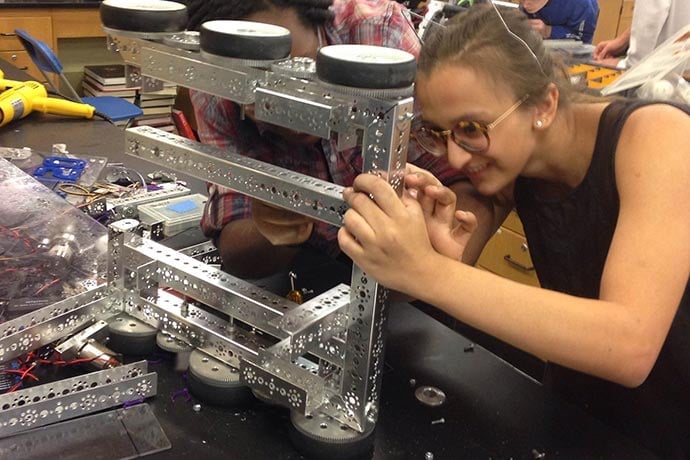For those unfamiliar to the process, building a robot might sound complex and difficult. However, as proved every year by rookie For Inspiration and Recognition of Science and Technology (FIRST) robotics teams, it can be done without extensive prior experience or ability. After weeks or months of hard work, students claim to have the greatest feeling of gratification while watching their robot work in competitions.
FIRST offers four different level programs for students of ages 6-18 and each one promotes the idea all students are capable of learning how to build a robot, regardless of their previous amount of exposure to STEM. With a coach and mentors, students throughout the world join and form FIRST teams to explore robotics and the results are outstanding.
The FIRST community also is expanding rapidly as educators and students realize the benefits of the program; from enjoyment of the activity to the opportunities it opens for students considering careers in STEM, this robotics competition is definitely worthwhile.
Each year, FIRST releases a new game challenge for each program, including new rules, competition field components, and methods to score points.
After teams (except rookies) scrap their robots from last year, the design phase commences. When looking at the finished products, it is difficult for some to believe that teams begin with only ideas. There is no denying the process may be time-consuming, but time spent on improving designs makes a dramatic impact on the success of the robot. In most cases, final robots look nothing like a team’s initial design ideas.
The process begins with a collaboration of individual team members’ ideas. After plenty of discussion, debating pros and cons, drawing ideas, and eliminating problematic designs, the first prototypes are created. Typically made with basic materials like cardboard and tape, prototypes are great for helping visualize an idea in approximate size. They also quickly reveal any problems with an idea that were not previously recognized.
Although frustrating to discover an idea that appeared promising will not work, teams learn the importance of trial and error, a typical skill of an engineer. Prototypes are also useful when choosing between different designs for a mechanism if both seem effective at first. Throughout the process, the competition encourages students to record all ideas and versions of designs in an engineering notebook.
Once designs are finalized, CAD drawings are made and materials are selected for building the mechanisms. Using professional programs like Solidworks or Autodesk Inventor, some students create drawings of mechanisms with precise dimensions. This requires practice and experience, but there are a multitude of free tutorials available online.

Complete assemblies of robots are highly rewarded in competition. When choosing materials, students consider which material would be most efficient, yet also possibly unique or innovative. Depending on available resources, teams often use Tetris parts or pieces made with 3D printers or CNC machines.
Building the final mechanisms on the robot may be considered the most fun, but it often includes making a series of adjustments. Slight changes are often made to improve the efficiency of the robot, especially once the robot is wired and test driven. Robots require less fixing if they are planned thoroughly, so the time spent perfecting designs is definitely worth it.
Mentors are extremely useful in each phase of building the robot, offering advice and knowledge from experience. FIRST encourages students to search for as many mentors as they can find to enhance their experience on the team. Similarly, professionals in STEM fields are encouraged to help FIRST teams, as they can also benefit from the experience while inspiring students.
“I think robotics encourages creativity and independent thought,” Mike Christ, a mentor for Hewlett High School’s FIRST FTC teams, said. “You have to solve problems and work with others, as well as have leadership and public speaking skills.”
At the surface, the process is merely building a robot; however, it involves critical thinking skills that can be used in a multitude of areas. Students benefit greatly from robotics teams, even if they are not considering a career in the STEM field. Communication and logic are crucial for creating a successful robot, and students usually learn these skills without even realizing it.
“I think it makes you a better person, it’s really going to help later in life,” Christ said.
Learn More
FIRST Robotics Competition
Bionica Team’s Instagram
Our all girl robotics team posts pictures as we design, build, and compete with our robot.
https://instagram.com/7120bionica/

